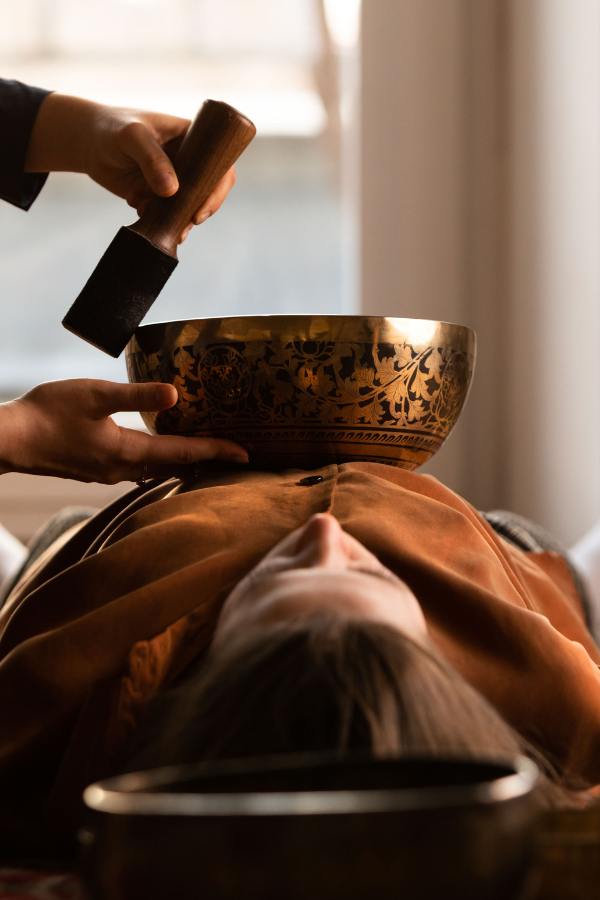

The Role of Sound Baths in Stress Reduction
Summary
Reflection Questions
Journal Prompt
As female creatives with all the pressures of modern life, we are often in search of inner peace and stress reduction. Amidst the hustle and bustle of our daily lives, we seek mindfulness practices that shut out the noise. Sound baths, rooted in centuries-old traditions, are increasingly popular because of their ability to soothe the mind, alleviate stress, and promote overall well-being. In this article, we delve into the transformative role sound baths can play in stress reduction. Read on to learn more.
What is Sound Meditation?
Sound bathing, also known as sound meditation, is a meditative practice that involves participants being immersed in sound waves produced by various instruments, such as singing bowls, gongs, tuning forks, and sometimes voice. These sounds are played in a therapeutic manner, with the intention of bringing about healing and relaxation. The practice is based on the principle that everything in the universe, including our bodies, is in a state of vibration. Sound baths aim to bring those experiencing it into a state of harmonic resonance and promote well-being.
The Roots of Sound Bath Meditation


The practice of sound bathing, while popularized in modern wellness and spiritual circles, has deep historical roots that span across different cultures and epochs. Each culture utilized sound and vibration for its therapeutic and spiritual benefits, highlighting a universal recognition of sound’s power to heal, transform, and elevate the human experience. While the instruments, techniques, and intentions may vary, the underlying principle of using sound as a tool for healing and spiritual connection remains a common thread that connects these ancient practices to the contemporary phenomenon of sound bathing.
Ancient Tibetan Practices
Sound bathing has connections to ancient Tibetan practices involving singing bowls made from various metals. These bowls produce harmonious sounds and vibrations when rubbed or struck. The primary use was for religious ceremonies, meditation, and deep healing practices. The vibrations were believed to balance the body’s energy, promote healing, and facilitate a deeper state of meditation.
Indigenous Australian Traditions
Indigenous Australians have used the didgeridoo, a wind instrument, for over a thousand years in healing ceremonies. The deep, resonant sounds of the didgeridoo are considered to have healing properties, particularly for healing broken bones and muscle tears, as well as promoting spiritual well-being.
Ancient Greek History
The ancient Greeks used music as a form of medicine, believing it could heal both the body and the soul. They used various instruments like lyres and flutes to promote health and well-being. Philosophers like Pythagoras emphasized the importance of music and sound for harmony in the body and soul, leading to practices that resemble modern sound bathing.
Hinduism and Buddhism
Sound plays a crucial role in Hindu and Buddhist traditions, where chanting mantras and other forms of vocal sound are used for meditation, healing, and spiritual practice. Apart from Tibet, these practices have been adopted and integrated into various aspects of Hindu and Buddhist rituals, emphasizing the power of sound for spiritual and physical healing.
Ancient Egyptian Practices
The ancient Egyptians used vocal chants and music in their healing temples, believing in the power of sound vibrations to heal and restore health. Instruments and vocal sounds were chosen for their ability to create specific vibrational frequencies believed to have therapeutic effects.
Key Components of Sound Healing


Common sound healing instruments include Tibetan singing bowls, crystal singing bowls, gongs, didgeridoos, musical instruments, and tuning forks. Each instrument produces unique vibrations and tones that can affect the body and mind differently throughout the sound healing session.
The goal of sound bathing is to calm the nervous system and promote spiritual well being. As such, sound baths typically take place in a quiet, comfortable space where participants can either lie down or sit comfortably. The environment is designed to be conducive to relaxation and introspection.
Whether you opt for a singing bowl sound meditation or a gong session, a skilled practitioner or sound healer leads the session, using their knowledge of the instruments to create a flow of sounds that guide participants through an immersive auditory experience. To begin, participants close their eyes and focus on the sounds, allowing the vibrations to wash over them—hence the term “sound bathing”. The experience is often described as being enveloped in sound, which can lead to deep relaxation and a meditative state.
How Sound Bathing Works
The therapeutic effects of sound bathing are believed to be related to the concept of entrainment—the process by which the powerful vibrations from the sound bath instruments bring the body’s internal rhythms (like heart rate and brain waves) into synchronization with the sound waves. This can lead to a state of deep relaxation and meditative awareness, where healing and profound insights can occur.
Sound Bath Benefits
The benefits of sound bathing are multifaceted, touching on physical, mental, emotional, and spiritual dimensions of wellbeing. By leveraging the therapeutic power of sound vibrations, this ancient practice offers a unique and powerful way to achieve relaxation, enhance mental clarity, foster emotional healing, and deepen spiritual connection. Let’s explore the healing power of sound bathing!
Physical Relaxation and Stress Reduction
One of the most immediate physical health benefits of sound bathing is its profound impact on the body’s relaxation response. The soothing, resonant vibrations produced by sound therapy instruments can help lower blood pressure, reduce heart rate, and decrease stress hormones, leading to a state of deep relaxation.
This relaxation response is not merely subjective; it has been observed in various studies that link sound therapy with reductions in stress and anxiety levels. By engaging the parasympathetic nervous system, sound bathing facilitates a healing state where the body can repair and rejuvenate itself, making it an effective practice for stress reduction.
Enhanced Mental Clarity and Focus


Sound bathing also offers cognitive benefits, including improved focus, clarity, and creativity. The immersive nature of the sound experience helps to quiet the mind, reducing the stream of thoughts that often leads to distraction and overwhelm. This mental quietude can open up space for deeper insights and may enhance problem-solving abilities and creative thinking. Participants often report emerging from sound baths feeling mentally refreshed and more capable of handling complex tasks and challenges.
Emotional Healing and Mental Health
On an emotional level, sound bathing can be a powerful tool for emotional healing and wellbeing. The vibrational frequencies of the sounds can resonate with the body on a cellular level, potentially releasing stored tensions and emotional blockages.
This process can facilitate a deep emotional release, allowing individuals to process and move through feelings of grief, sadness, or anxiety in a supportive and safe environment. Many find sound bathing to be a profoundly cathartic experience, leading to increased emotional resilience and a greater sense of peace and wellbeing.
Spiritual Connection and Mindfulness
Sound bath sessions often serve as a gateway to deeper spiritual exploration and mindfulness practices. The immersive sonic environment can help deepen meditation practices, enhancing the ability to remain present and connected to one’s inner experience.
For many, sound bathing is a spiritual experience that fosters a sense of interconnectedness with the universe and a deeper understanding of oneself. This heightened state of awareness can contribute to a more mindful approach to daily life, encouraging a sense of calm and centeredness in the face of life’s challenges.
Cultural Considerations Surrounding Sound Healing


The sound bathing concept is rooted in ancient practices found across various cultures, including Tibetan singing bowl ceremonies, Aboriginal didgeridoo healing, and the use of Gregorian chants in Christian traditions. Acknowledging and respecting the origins and historical significance of these practices is crucial. Cultural appropriation concerns arise when practitioners use these cultural elements without understanding or respecting their origins and meanings.
There’s a fine line between cultural exchange, where there is mutual sharing and respect, and cultural appropriation. The difference often lies in the power dynamics at play, the context of the exchange, and the impact on the source culture. Engaging with sound bathing practices in a way that respects their cultural origins involves thorough research, sensitivity to cultural nuances, and, where possible, learning from traditional practitioners. It also means avoiding the dilution or distortion of these practices in ways that strip them of their cultural significance.
Practitioners and participants alike should educate themselves about the cultural histories and significances of the practices they engage in. Where possible, supporting a sound healing practitioner from within the originating cultures can help ensure the sustainability and authenticity of these traditions. Approaching sound bathing with sensitivity to its cultural roots and seeking guidance or consent from cultural custodians when necessary.
Final Thoughts on the Stress Reduction Benefits of the Sound Bath Experience
By immersing oneself in soothing and harmonious vibrations, individuals can experience a profound sense of calm, inner balance, and mental clarity. As the calming waves of sound wash over them, stress melts away, leaving a renewed sense of well-being and tranquility. Sound bathing not only provides a respite from the demands of modern life but also promotes physical and emotional healing. Its accessible and holistic approach makes it a valuable tool in managing stress and enhancing overall mental and emotional health, allowing individuals to find solace and serenity amidst the cacophony of everyday life. Let us know if you have experienced one of many different sound baths in the comments below.








